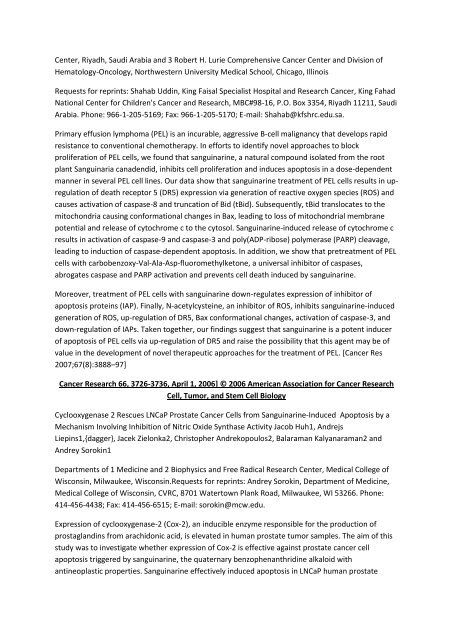Black Salve Alternative Cancer Treatment (1)
You also want an ePaper? Increase the reach of your titles
YUMPU automatically turns print PDFs into web optimized ePapers that Google loves.
Center, Riyadh, Saudi Arabia and 3 Robert H. Lurie Comprehensive <strong>Cancer</strong> Center and Division of<br />
Hematology-Oncology, Northwestern University Medical School, Chicago, Illinois<br />
Requests for reprints: Shahab Uddin, King Faisal Specialist Hospital and Research <strong>Cancer</strong>, King Fahad<br />
National Center for Children's <strong>Cancer</strong> and Research, MBC#98-16, P.O. Box 3354, Riyadh 11211, Saudi<br />
Arabia. Phone: 966-1-205-5169; Fax: 966-1-205-5170; E-mail: Shahab@kfshrc.edu.sa.<br />
Primary effusion lymphoma (PEL) is an incurable, aggressive B-cell malignancy that develops rapid<br />
resistance to conventional chemotherapy. In efforts to identify novel approaches to block<br />
proliferation of PEL cells, we found that sanguinarine, a natural compound isolated from the root<br />
plant Sanguinaria canadendid, inhibits cell proliferation and induces apoptosis in a dose-dependent<br />
manner in several PEL cell lines. Our data show that sanguinarine treatment of PEL cells results in upregulation<br />
of death receptor 5 (DR5) expression via generation of reactive oxygen species (ROS) and<br />
causes activation of caspase-8 and truncation of Bid (tBid). Subsequently, tBid translocates to the<br />
mitochondria causing conformational changes in Bax, leading to loss of mitochondrial membrane<br />
potential and release of cytochrome c to the cytosol. Sanguinarine-induced release of cytochrome c<br />
results in activation of caspase-9 and caspase-3 and poly(ADP-ribose) polymerase (PARP) cleavage,<br />
leading to induction of caspase-dependent apoptosis. In addition, we show that pretreatment of PEL<br />
cells with carbobenzoxy-Val-Ala-Asp-fluoromethylketone, a universal inhibitor of caspases,<br />
abrogates caspase and PARP activation and prevents cell death induced by sanguinarine.<br />
Moreover, treatment of PEL cells with sanguinarine down-regulates expression of inhibitor of<br />
apoptosis proteins (IAP). Finally, N-acetylcysteine, an inhibitor of ROS, inhibits sanguinarine-induced<br />
generation of ROS, up-regulation of DR5, Bax conformational changes, activation of caspase-3, and<br />
down-regulation of IAPs. Taken together, our findings suggest that sanguinarine is a potent inducer<br />
of apoptosis of PEL cells via up-regulation of DR5 and raise the possibility that this agent may be of<br />
value in the development of novel therapeutic approaches for the treatment of PEL. [<strong>Cancer</strong> Res<br />
2007;67(8):3888–97]<br />
<strong>Cancer</strong> Research 66, 3726-3736, April 1, 2006] © 2006 American Association for <strong>Cancer</strong> Research<br />
Cell, Tumor, and Stem Cell Biology<br />
Cyclooxygenase 2 Rescues LNCaP Prostate <strong>Cancer</strong> Cells from Sanguinarine-Induced Apoptosis by a<br />
Mechanism Involving Inhibition of Nitric Oxide Synthase Activity Jacob Huh1, Andrejs<br />
Liepins1,{dagger}, Jacek Zielonka2, Christopher Andrekopoulos2, Balaraman Kalyanaraman2 and<br />
Andrey Sorokin1<br />
Departments of 1 Medicine and 2 Biophysics and Free Radical Research Center, Medical College of<br />
Wisconsin, Milwaukee, Wisconsin.Requests for reprints: Andrey Sorokin, Department of Medicine,<br />
Medical College of Wisconsin, CVRC, 8701 Watertown Plank Road, Milwaukee, WI 53266. Phone:<br />
414-456-4438; Fax: 414-456-6515; E-mail: sorokin@mcw.edu.<br />
Expression of cyclooxygenase-2 (Cox-2), an inducible enzyme responsible for the production of<br />
prostaglandins from arachidonic acid, is elevated in human prostate tumor samples. The aim of this<br />
study was to investigate whether expression of Cox-2 is effective against prostate cancer cell<br />
apoptosis triggered by sanguinarine, the quaternary benzophenanthridine alkaloid with<br />
antineoplastic properties. Sanguinarine effectively induced apoptosis in LNCaP human prostate



